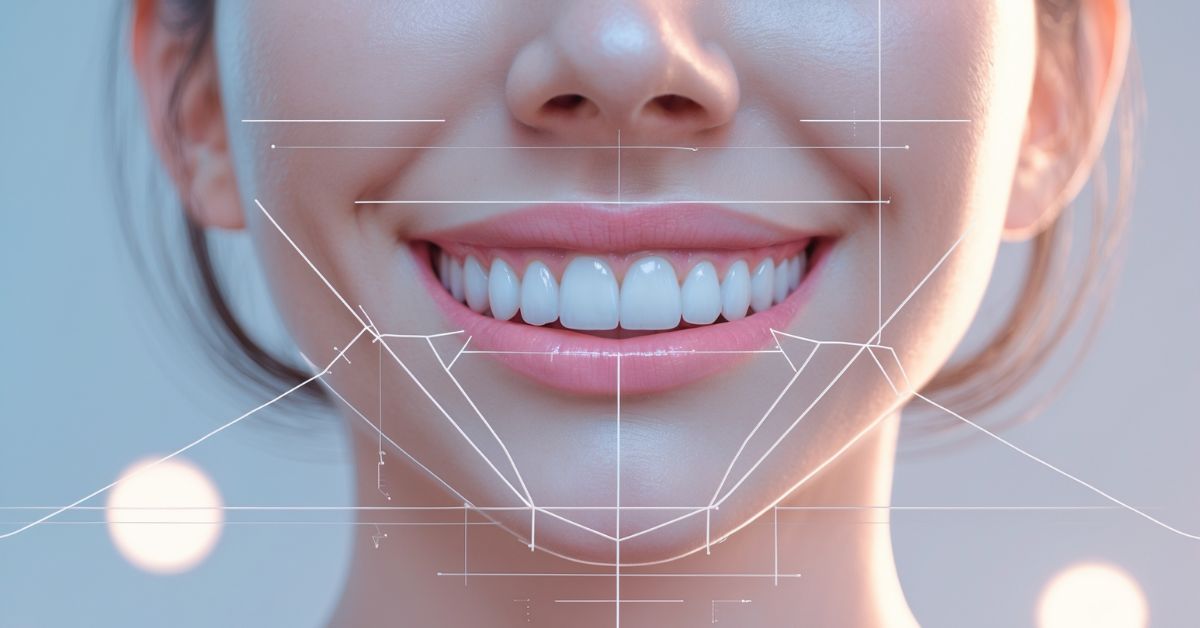Balancing Beauty: The Science of a Symmetrical Smile

Facial balance, particularly a harmonious smile, greatly contributes to overall facial aesthetics and perceptions of attractiveness. This connection between dental symmetry and facial beauty blends art and science, with a balanced smile indicating health and vitality.
The Golden Ratio: Nature’s Blueprint for Beauty
For centuries, artists, architects, and mathematicians have been captivated by a concept known as the Golden Ratio. This mathematical principle, approximately equal to 1.618, is found throughout nature—from the spiral of a seashell to the arrangement of petals on a flower. It’s often considered a universal benchmark for beauty and harmony.
When applied to facial aesthetics, the Golden Ratio helps define ideal proportions. It can be used to measure the relationship between the width of the mouth and the nose, the distance between the eyes, and the overall dimensions of the face. A face that closely adheres to these proportions is often perceived as more aesthetically pleasing. Dentists and cosmetic specialists use this principle as a guide when designing smiles, ensuring that the size and placement of teeth create a balanced and attractive result that complements the rest of the facial features.
What is Dental Symmetry?
Dental symmetry refers to the balance and alignment of your teeth and jaw. It’s not just about having perfectly straight teeth; it involves several key components working together to create a harmonious smile.
Elements of a Symmetrical Smile
- Midline Alignment: An ideal smile has a midline—the line between your two upper front teeth—that lines up perfectly with the center of your face. A misaligned midline can make your entire smile appear off-center.
- Tooth Size and Shape: The size and shape of your teeth should be proportional to each other. For example, your two front teeth should be mirror images, and the teeth on either side should gradually decrease in size in a balanced way.
- Gum Line: The curve of your gum line should be symmetrical and follow the line of your upper lip when you smile. An uneven gum line can detract from the overall balance.
- Bite and Jaw Alignment: Your upper and lower teeth should fit together correctly, and your jaw should be balanced. An imbalanced bite can affect not only your smile’s appearance but also your facial structure.
When these elements are in harmony, the result is a smile that enhances your entire facial appearance, contributing to a look of health, youth, and attractiveness.
Common Issues Affecting Dental Symmetry
Several common dental problems can disrupt the natural balance of your smile and, by extension, your facial aesthetics.
- Misaligned Teeth: Crooked, crowded, or gapped teeth are one of the most obvious causes of dental asymmetry.
- Jaw Asymmetry: An underdeveloped or misaligned jaw can cause the lower part of the face to appear unbalanced. This can result from genetics, developmental issues, or even injury.
- Uneven Wear: Grinding your teeth (bruxism) or having a poor bite can cause uneven wear, leading to teeth of different lengths and shapes.
- Missing Teeth: A missing tooth creates a noticeable gap and can cause surrounding teeth to shift, disrupting the smile’s midline and overall alignment.
- Overbites and Underbites: When your upper or lower jaw protrudes significantly, it affects your facial profile and the way your lips and cheeks are supported.
These issues do more than just affect your appearance; they can also lead to functional problems like difficulty chewing, jaw pain, and an increased risk of dental decay.
How to Improve Your Smile’s Symmetry
Fortunately, modern dentistry offers a range of effective treatments to correct asymmetry and create a more balanced, beautiful smile.
Orthodontics
Orthodontic treatments are the go-to solution for correcting misaligned teeth and bite issues.
- Braces: Traditional braces are highly effective for complex alignment problems.
- Clear Aligners: Invisalign and other clear aligner systems offer a more discreet way to straighten teeth and are suitable for many cases of mild to moderate misalignment.
Cosmetic Dentistry
For issues related to tooth shape, size, or color, cosmetic dentistry provides excellent solutions.
- Veneers: These thin shells of porcelain are bonded to the front of teeth to create a perfectly uniform and symmetrical appearance.
- Bonding: Dental bonding uses a tooth-colored resin to repair chips, close gaps, or reshape teeth.
- Crowns: Crowns can be used to restore the shape and size of a badly damaged or misshapen tooth, contributing to a more balanced smile. For more extensive needs, full mouth restorations like those in Lafayette, LA, can completely transform a smile by addressing multiple issues at once.
The Role of Modern Technology
The field of dentistry has been revolutionized by technology, enabling more precise assessments and predictable treatment outcomes.
- 3D Imaging and Digital Scanners: Dentists can now use 3D imaging and intraoral scanners to create highly detailed models of your teeth and jaw. This technology allows for meticulous planning of orthodontic or cosmetic procedures.
- Digital Smile Design (DSD): With DSD, you can see a digital preview of your new smile before treatment even begins. This collaborative process ensures that you and your dentist are aligned on the aesthetic goals, resulting in a final look that you’ll love.
- CAD/CAM Technology: Computer-Aided Design and Computer-Aided Manufacturing (CAD/CAM) allow for the precise, same-day creation of crowns and veneers, making smile transformations faster and more convenient than ever.
Maintaining Your Symmetrical Smile
After investing time and resources into achieving your ideal smile, it’s important to maintain the results.
- Wear Your Retainer: If you’ve had orthodontic treatment, wearing your retainer as prescribed is crucial to prevent teeth from shifting back.
- Practice Good Oral Hygiene: Regular brushing, flossing, and dental check-ups will keep your teeth and gums healthy and prevent issues that could compromise your smile.
- Use a Nightguard: If you grind your teeth, a custom-fitted nightguard can protect your teeth from wear and damage.
- Be Mindful of Your Habits: Avoid habits like chewing on ice or pens, which can chip or damage your teeth.
Conclusion
Now that you understand the importance of retainers in maintaining a straight smile, it’s important to follow your orthodontist’s instructions and practice good oral hygiene. By doing so, you can ensure that your beautiful new smile lasts a lifetime.
Also Read: Pravi Celer Explained: From Garden to Table






